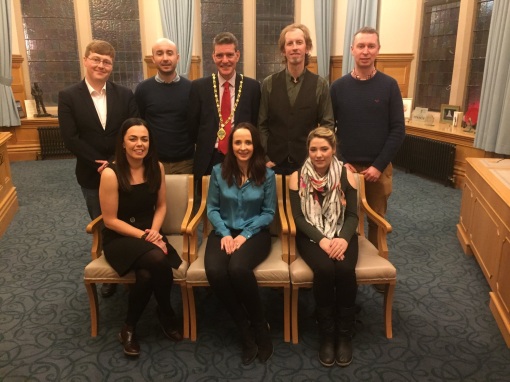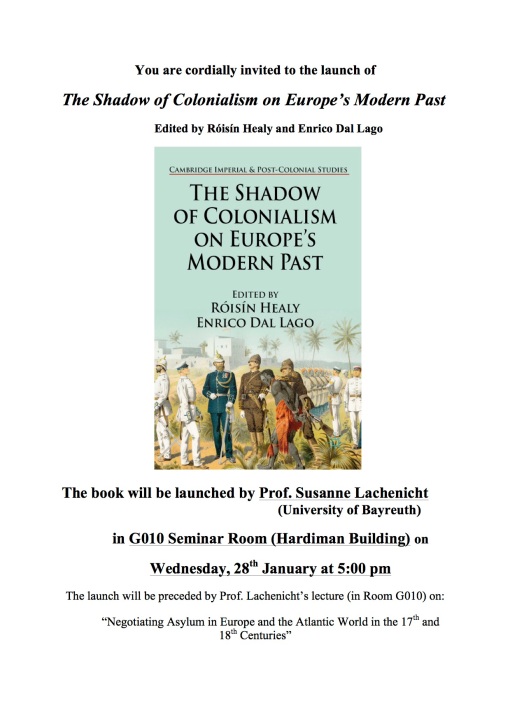Friday the 23 February 2018 saw me on the road to Derry-Londonderry to take part in the 68th Annual Irish History Students’ Association Conference and my first conference presentation. https://ihsa2018.wordpress.com/
This year’s IHSA conference was held at the Magee campus of the University of Ulster. It began with a reception in what is indeed a Great Hall and all the attendees were given a warm, bi-lingual welcome by the provost, Dr Malachy O’Neill. While slightly intimidating to be on my own, people were friendly and the organising committee members made themselves known to us and were very hospitable. Thank you Kyle, Krysta, and Leanne in particular, friendliness and generosity of spirit and information remained a key theme amongst everybody throughout the conference. It was also remarkable and encouraging that so many people had presented for the first time at this conference previously.
Saturday involved no less than five sessions with two or three panels, an astonishing 39 papers in all. They were on a remarkable array of topics. They ranged from Early Modern Kingship, Identity and Linguistics, Re-evaluating Education in 20th Century Ireland, Women in the Domestic and Public Spheres, Radicalism, Religion and Race, Transnational Connections and Influence, Sexuality in Ireland, Institutionalised Irish Patients, Crime and Criminal Behaviour, Politics, Domesticity and Identity, Manuscripts and Connections (Gaeilge), Revolutionary Ireland: Evolution and Aftermath, The Troubles: Social and Political Impact, Early 20th Century Political and Military Organisation and Political and Cultural Tensions in Troubled Times. The closing keynote lecture was given by Prof Breandán MacSuibhne, author of The End of Outrage: Post-Famine Adjustment in Rural Ireland – recent winner of the Irish Times non-fiction book of the year award. He provided us with some interesting aspects of his research process. This was followed by a Mayoral reception in the Guildhall. The Conference dinner was held in the Maldron Hotel later that evening.
The panel I presented on was “Politics, Domesticity and Identity”. Laura Mather of Mary Immaculate College Limerick spoke on “Politics and Domesticity: the lives of Pamela Fitzgerald and Lucy Fitzgerald, 1796-1797”. This paper examined their personal letters to each other, which displayed some personal and political aspects to their lives. I spoke on “Anglo-Irish Identity and the Dillon family of Galway: The Clonbrock Photographic Collection”. For this, I used an extract from my BA minor dissertation for Irish Studies on the Dillon family and the Clonbrock Photographic Collection. Thanks to the help of others, I charted a very steep learning curve on presenting prior to the conference. Lessons learnt were (1) while some words work great in text, they may be tongue tripping in speech, (2) there will be nerves, (3) your mouth will dry up and (4) you may pass out if you forget or do not leave time to breathe!
The bottle of water, the text broken up into small portions and liberally sprinkled with the words ‘breathe’, ‘pause’, ‘long pause’, ‘take a drink of water’ and ‘next slide’ worked very well. The paper was timed precisely, the Powerpoint worked well and the one transition slide that announced the ‘Great Reveal’ functioned well to add to the drama. Feedback from the Chair, Dr Paul O’Brien of Mary Immaculate College Limerick, was constructive and complimentary. The paper generated questions surrounding the Anglo-Irish Dillon family, Photography and Lady Augusta Dillon. A discussion took place on the benefits of viewing primary sources in reality, if possible, even if they are available via a database. I was delighted with the end result.
And so now, I will be one of those people proud to say their first conference paper was at an IHSA conference.


Would I do it again? In a heartbeat.
So, thanks again to all on the IHSA committee, for more info on IHSA 2019 to be held in MIC or the prizes on offer see https://ccsihsa.jimdo.com/; @IHSA1950 or https://www.facebook.com/events/351934461979032/
Úna Kavanagh, MA student, Department of History NUI Galway











Recent Comments